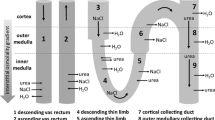Summary
The transepithelial electrical potential difference was measured across hamster kidney collecting duct epithelium during antidiuresis in vivo. Measurements were obtained in free-flow, stop-flow and during luminal and peritubular perfusion with various salt solutions. The data show a significant lumen negative potential difference during free-flow, which appears to be shunted in the lower region of the papilla through the open end of the collecting ducts. Elimination of the shunt by injection of insulating material into the duct orifice raised the potential difference to an average of −34±7.7 mV (stop-flow condition). During luminal and peritubular perfusion with identical NaCl solution the potential difference averaged −55 mV. In contrast to many other epithelia it remained high, when all Na was replaced by K in the lumen compartment, but dropped to near zero upon substitution of Na by chline. During luminal perfusion with Na2SO4 the potential difference increased to −83 mV. The data suggest that the luminal membrane of collecting duct cells is permeable to both Na and K ions as well as to chloride, but that its choline and sulfate permeability is small. The main source for the potential difference appears to be active Na-transport.
Similar content being viewed by others
References
Baldamus, C. A., Hierholzer, K., Rumrich, G., Stolte, H., Uhlich, E., Ullrich, K. J., Wiederholt, M.: Natriumtransport in den proximalen Tubuli und in den Sammelrohren bei Variation der Natriumkonzentration im umgebenden Medium. Pflügers Arch.310, 354–368 (1969).
Diezi, J., Michoud, P., Aceves, J., Giebisch, G.: Micropuncture study of electrolyte transport across papillary collecting duct of the rat. Amer. J. Physiol.224, 623–634 (1973).
Frömter, E.: Progress in microelectrode techniques for kidney tubules. Yale J. Biol. Med.45, 414–425 (1972).
Frömter, E.: Electrophysiology and isotonic fluid absorption of proximal tubules of mammalian kidney. Int. Rev. Sci., Physiol. Ser. I,6, 1–38 (1974)
Frömter, E., Diamond, J. M.: Route of passive ion permeation in epithelia. Nature New Biol.235, 9–13 (1972).
Frömter, E., Gebler, B., Schopow, K., Pockrandt-Hemstedt, H.: Cation and anion permeability of rabbit submaxillary main duct. In: Secretory mechanisms of exocrine glands, N.A. Thorn, O. H. Petersen and J. H. Thaysen, Eds. Copenhagen: Munksgard 1974 (in press)
Frömter, E., Hegel, U.: Transtubuläre Potentialdifferenzen an proximalen und distalen Tubuli der Rattenniere. Pflügers Arch. ges. Physiol.291, 107–120 (1966)
Frömter, E., Müller, C. W., Wick, T.: Permeability properties of the proximal tubular epithelium of the rat kidney studied with electrophysiological methods. In: Electrophysiology of epithelial cells, G. Giebisch, Ed., pp. 119–146. Stuttgart-New York: F. K. Schattauer 1971
Grantham, J. J., Burg, M. B., Orloff, J.: The nature of transtubular Na and K transport in isolated rabbit renal collecting tubules. J. clin. Invest.49, 1815–1826 (1970).
Helman, S. I., Grantham, J. J., Burg, M. B.: Effect of vasopressin on electrical resistance of renal cortical collecting tubules. Amer. J. Physiol.220, 1825–1832 (1971)
Hierholzer, K.: Secretion of potassium and acidification in collecting ducts of mammalian kidney. Amer. J. Physiol.201, 318–324 (1961)
Hilger, H. H., Klemmer, J. D., Ullrich, K. J.: Wasserückresorption und Ionentransport durch die Sammelrohrzellen der Säugetierniere. Pflügers Arch. ges. Physiol.267, 218–237 (1958).
Laurence, R., Marsh, D. J.: Effect of diuretic states on hamster collecting duct electrical potential differences. Amer. J. Physiol.220, 1610–1616 (1971)
Leb, D. E., Hoshiko, T., Lindley, B. D.: Effects of alkali metal cations on the potential across toad and bullfrog urinary bladder. J. gen. Physiol.48, 527–540 (1965)
Malnic, G., Giebisch, G.: Some electrical properties of distal tubular epithelium in the rat. Amer. J. Physiol.223, 797–808 (1972)
Marsh, D. J., Solomon, S.: Analysis of electrolyte movement in thin Henle's loops of hamster papilla. Amer. J. Physiol.208, 1119–1128 (1965).
Rau, W. S., Frömter, E.: Electrical properties of the medullary collecting ducts of the golden hamster kidney. II. The transepithelial resistance. Pflügers Arch.351, 113–131 (1974).
Reuter, U. H.: Electrical potential in the urological cavity system and parenchyma. Urol. Res.2, 21–25 (1974).
Sakai, F., Jamison, R. L., Berliner, R. W.: A method for exposing the rat renal medulla in vivo: micropuncture of the collecting duct. Amer. J. Physiol.209, 663–668 (1965)
Sakai, F., Tadokoro, M.: Transtubular potential differences of the renal collecting duct of golden hamster. Jap. J. Pharmacol.16, 491–492 (1966)
Stackelberg, W. F. v: Der Einfluß hydrostatischer Druckdifferenzen auf den aktiven Natriumt ansport durch die Froschhaut. Pflügers Arch.310, 128–136 (1969).
Uhlich, E., Baldamus, C. A., Ullrich, K. J.: Einfluß von Aldosteron auf den Natriumtransport in den Sammelrohren der Säugetierniere. Pflügers Arch.308, 111–126 (1970).
Ussing, H. H.: The alkali metal ions in isolated systems and tissues. In: Handbuch der experimentellen Pharmakologie, O. Eichler and A. Farah, Eds., pp. 1–195. Berlin-Göttingen-Heidelberg: Springer 1960
Windhager, E. E.: Electrophysiological study of renal papilla of golden hamsters. Amer. J. Physiol.206, 694–700 (1964)
Author information
Authors and Affiliations
Rights and permissions
About this article
Cite this article
Rau, W.S., Frömter, E. Electrical properties of the medullary collecting ducts of the golden hamster kidney. Pflugers Arch. 351, 99–111 (1974). https://doi.org/10.1007/BF00587430
Received:
Issue Date:
DOI: https://doi.org/10.1007/BF00587430




